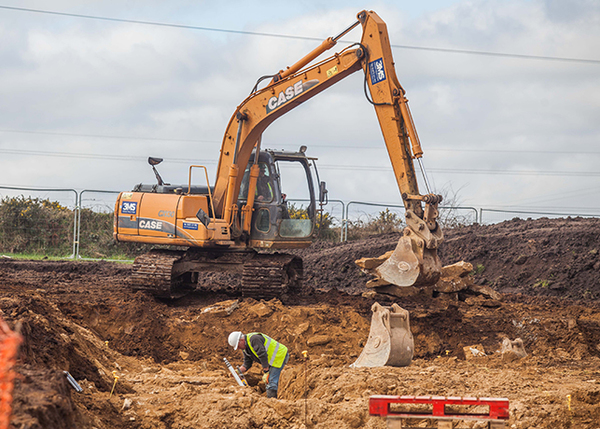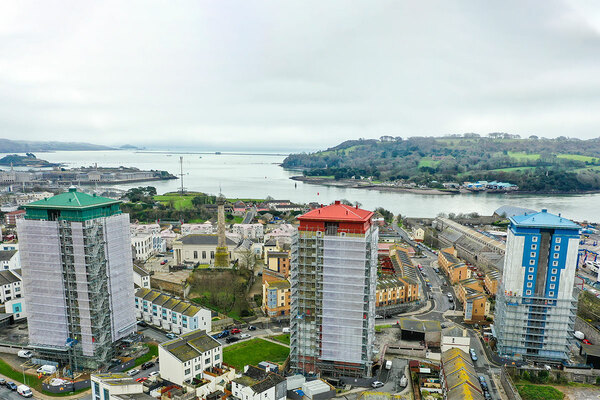You are viewing 1 of your 1 free articles
Lessons from Cornwall: how to tackle the housing crisis
England’s most remote county might not seem like somewhere troubled by the housing crisis. But, as Gavriel Hollander discovers, Cornwall could be an example for the rest of the country to follow. Photography by Alamy
Promenade and town houses in St Ives, Cornwall
If you were asked to name the local authority area that delivered the highest number of new affordable homes in 2017/18, which parts of the country would spring to mind? Manchester or Birmingham, perhaps? Or maybe one of the larger London boroughs?
How about Cornwall? It may seem out of step with the county’s bucolic image, but Cornwall has been addressing a housing crisis in recent years just as acute as any in those urban centres. What’s different, however, is how this crisis manifests itself in England’s furthest flung corner.
The 912 affordable homes built in Cornwall in 2017/18 (the last year in which full figures are available) puts it top of the charts when it comes to delivery of the tenures that are collectively described as ‘affordable housing’, having been consistently in the top three or four in recent years.
So why the need for so much activity in the county? And what is driving the recent uptick in delivery?
It should be noted that it is a shortage of housing of all tenures in the county. The National Housing Federation’s (NHF) Home Truths analysis in 2017/18 found there had been a delivery shortfall of nearly 3,000 homes over the five years immediately before its analysis. That’s even after taking into account the average of 2,548 additional homes built in Cornwall in the 10 years up to 2016/17.
But more importantly, there is a particular affordability problem in this part of the world.
“Cornwall undoubtedly has one of the biggest issues of affordability [in the country],” declares Chris Weston, director of development and commercial services at Coastline Housing, one of the area’s biggest – and most ambitious – associations.
The affordability gap in Cornwall applies both to buyers and renters, and it is a problem fed by the nature of the local jobs market. While unemployment is relatively low here – running at 2.7% as opposed to the national UK average of 3.8% according to latest figures – much of the work is transient.
“It’s not necessarily about super-high house prices, but because of the multiplier of wages,” adds Mr Weston. “There’s very high employment but a lot of employment is seasonal, low-wage, unreliable income so it’s about the multiplier.”
That multiplier – the ratio of median house prices to median income – is high across many parts of the South West and certainly in Cornwall, where it is running at 9.3 according to latest Office for National Statistics figures, compared with an average of eight across England. Even that figure, however, is much higher in certain parts of the county, specifically the coastal towns where the prevalence of second homes and holiday lets has constrained supply and pushed up prices.
“There’s a danger with county-wide generalisations that it risks missing the point, as you get a huge amount of variation within Cornwall,” explains Jon Lloyd-Owen, service director for housing at Cornwall Council. “The coastal areas have got a significant second home and holiday market and the impact that has on house prices and the rental market is considerable. There, wages don’t flex similarly so affordability issues can be extremely acute. So it’s a varied picture across the Duchy.
“There’s a degree of seasonality, too. You have properties that move into the private rented sector for winter and become holiday lets in the summer, so housing availability and pressures have a seasonal aspect.”
Indeed, the NHF’s survey found that Cornwall had one of the largest caches of second homes anywhere in the country, with 13,767 recorded, exacerbated by another 3,230 long-term empty homes.
The situation reached the point where St Ives Town Council three years ago took the controversial step of restricting the sale of new homes to buyers who would use it as a primary residence.
While that move seems to have mixed results, the emphasis on county-wide is much more on how to increase supply and bring down cost.
Like many parts of the country, the 2010 introduction of the Affordable Homes Programme – where grant for social rent was effectively replaced by grant for the new ‘affordable rent’ tenure allowing landlords to charge up to 80% of market rent – had an impact on local providers in Cornwall. Although few housing associations were either willing or able to charge that top level of 80%, the effect was to stymie new development.
“Even if that 80% doesn’t get applied, RPs [registered providers] had the same issues in that they were required to sweat their assets,” explains Paul Butterworth, a Chartered Institute of Housing board member for the South West.
“One of the problems with that is, in a place like Cornwall, any small increase in rent, even if it’s not at 80%, puts a lot more pressure on people in terms of affordability.”
Coastline Housing’s Higher Nansloe development in Helston, Cornwall
However, at the same time as the concept of affordable rent was being concocted in Whitehall, another more local change was bedding in that would ultimately help Cornwall begin to address its housing problems.
In 2009, Cornwall became a unitary authority. This led to the drafting, a year later, of the county’s first strategic local plan – a plan that was ultimately adopted in 2016. This plan identified an affordable housing need of 52,500 homes over 20 years and began to outline how the council and its partners could deliver something approaching that number.
Mr Lloyd-Owen says the advent of the local plan was a key moment in the evolution of the county’s housing ambition.
“There was a very lively debate in Cornwall about the housing numbers,” he tells Inside Housing. “One of the issues in many rural areas – and no less in Cornwall – is about people wanting to safeguard the assets of a place like this: that means the landscape, the environment, the heritage – and we need to balance those considerations with the need to provide new homes for our residents.”
That local plan has helped the council and its housing association partners develop a coherent plan to up delivery that is clearly bearing fruit on a number of different fronts.
One of the council’s innovations has been to launch its own direct funding programme for housing associations, over and above Homes England’s national Affordable Homes Programme. The Cornwall Council Funded Programme (CCFP) is currently in its third iteration and has provided £14.6m over its first three years.
The county’s three largest housing associations – Coastline, LiveWest and Ocean Housing – have all upped their development programmes, in part thanks to the CCFP. The programme helped Coastline build 331 new homes in 2017/18 – its largest ever number – making it the second fastest growing association and propelling it into the top 40 nationwide. The association has a further 338 new homes planned for the current year and wants to maintain that level of development in the future.
Meanwhile, the council itself has also become a developer. Its Housing Development Programme, established in 2017, has committed £200m for 1,000 homes over four years and to create a model that could continue delivery on a similar scale beyond that. The programme is focused on private rent, with around half the homes built through it destined to remain in that sub-sector long term. Homes built through the programme will be run by the council’s own housing company and will be let as minimum five-year tenancies.
“It’s about a recognition that one in five households in Cornwall live in the PRS [private rented sector] and the quality is variable,” Mr Lloyd-Owen explains. “We wanted it to be an exemplar [to other landlords] in the major towns.”
The council has also been investing to reduce rough sleeping, spending £40m to acquire 250 properties across the county to be used as temporary accommodation. This has contributed to a 45% reduction in rough sleeping numbers in just two years. Meanwhile, the Nos Da Kernow (Good Night Cornwall) project works with individuals at risk of rough sleeping. It too was established in 2017 and went on to become a finalist at the UK Housing Awards the following year.
Cornwall remains a singular place. Yet the housing crisis – whether it be in the shape of supply, affordability or homelessness – is just as present here as anywhere else.
The strides it has made in tackling each of these shows the value of a joined-up, well-planned approach. Perhaps the rest of the country could benefit from casting its eyes westward.














